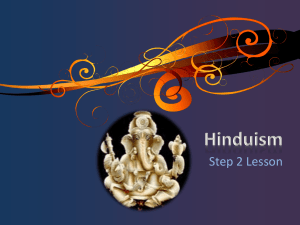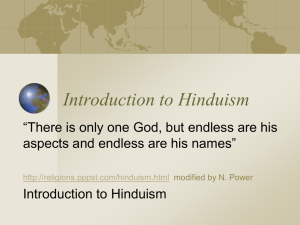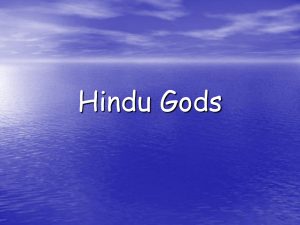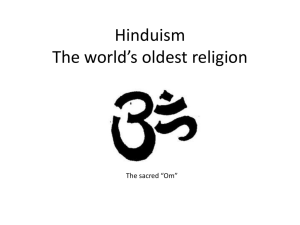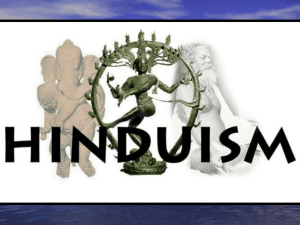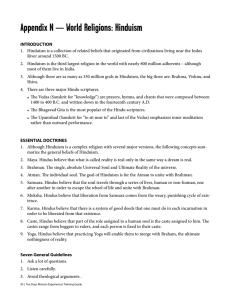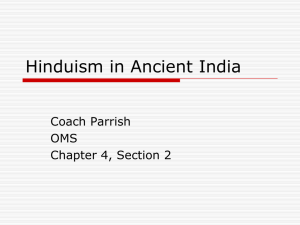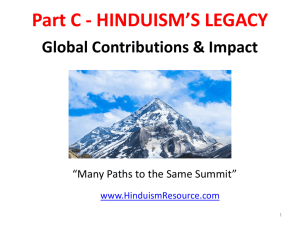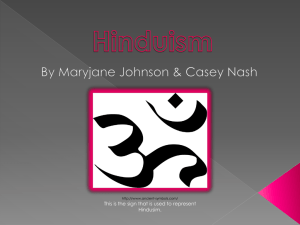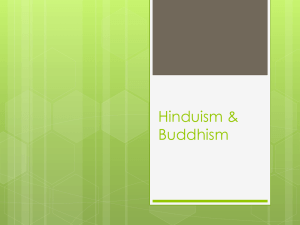Shiva's different depictions in Hindu art are
advertisement
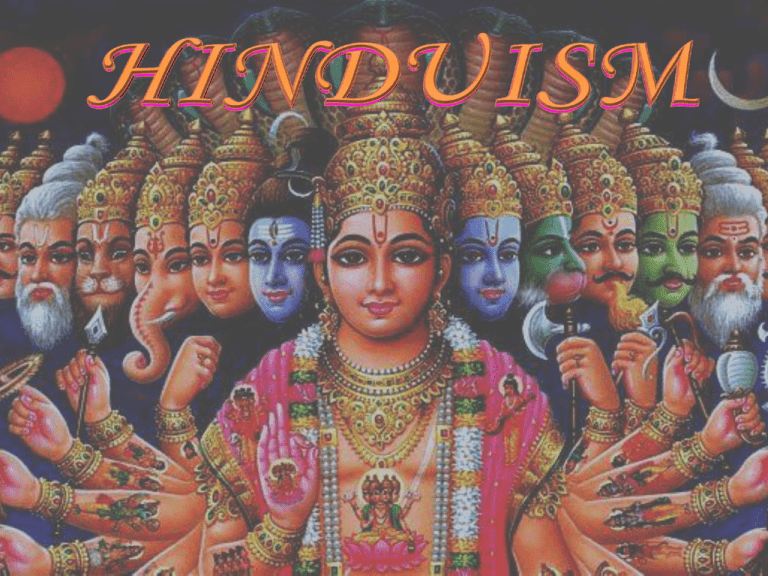
Hinduism is the faith of about 80 percent of India’s 1.2 billion people. It is unique among major world religions as it has no founder, not even in legend. It evolved among the Aryan tribes that invaded and settled India around 1500 BCE. Hinduism does not have a strict set of rules or teachings, but it still impacts the way that people live their lives. Hindus believe that the universe is an endless cycle of life, death, and rebirth. Play Video Segment #1 /Discovery Education On Desktop in Hinduism Folder / 6 min The beliefs of Hinduism are recorded in the four vast scriptures called the Vedas. The religion teaches that essentially all significant things are spiritual entities and can be considered deities, but that they are all but aspects of one spiritual power, Brahman, which created and controls the universe. The guiding principle for human beings is Dharma, or “right living,” which involves ethical behavior, observing ancient rituals, and other actions that are specific to one’s caste. India’s caste system generally is an outgrowth of Hinduism. It is explained in the Bhagavad Gita (“Song of the Lord”), considered by Hindus to be their most sacred text and is a part of the Mahabharata (“Great Tale of India”). REVIEW FROM VIDEO: HINDUISM Hinduism has no founder and no central organization. There is no prophet who handed down its basic ideas. These sacred teachings were passed down orally—by mouth—for hundreds of years. They were later written down in Sanskrit, the Aryan language, in a collection of writings called the Vedas. (there are 4 Vedas) The Vedas teach that there is one spiritual power, Brahman, which created and controls the universe; however, Hindus honor many gods and goddesses as aspects of that power. Planets, stars, chemical elements, and all forms of life are considered gods and goddesses. Anything that has beauty, value, or mystery is a potential god or goddess. One Hindu sage numbers the Hindu gods and goddesses at 330 million! Most Hindus believe that Brahma, Vishnu, and Shiva are the most important. https://www.youtube.com/watch?v=Y9yWwFWpbRo Hindu Creation Story Brahma was considered one of the revelations of the supreme deity. Hindus believe that Brahma was born from a golden egg and that he created the earth and all of its treasures. Brahma is usually shown with four faces and four arms that hold four objects: alms bowl ($ collection) a bow a book and prayer beads SIDE FACT: Contemporary Hinduism has no sect devoted to the worship of Brahma, and few temples are dedicated specifically to him. However, any temple that is dedicated to the worship of Vishnu or Shiva must also include an image of Brahma. Vishnu is the preserver and protector of the world. His role is to return to earth in troubled times to keep good and evil in balance. Vishnu has taken many different incarnations, or living forms. These include Rama and Krishna, but there are about 1,000 different names for Vishnu. Vishnu is often shown with blue skin and four arms, each one carrying a different object. a chakra, or discus, which symbolizes the mind; a mace, or club used as a weapon, which stands for strength. He is shown either standing upright on a lotus flower or lying on the coils of a serpent. SHIVA In the Indian philosophy the aspect of God that transforms and destroys what is no longer needed. He guides people through times of change. He the bringer of wisdom and joy through spiritual practice. He is the cosmic dancer who dances the world into being and lights the way for every seeker to find his eternal truth in his or her own heart. Shiva is represented in a variety of forms. In Sanskrit, his name means "Auspicious One." If a person is auspicious, he or she is hopeful. Shiva’s different depictions in Hindu • . art are numerous, but they all share some similarities. Shiva has three eyes, the third providing inward vision. When turned outward, this eye is capable of fiery destruction. Around Shiva’s neck is a serpent and a necklace of skulls. He is sometimes shown with as many as eight arms, with each hand holding a sacred object. Trimurti is the Hindu word for ‘trinity’ meaning ‘tri-unity’ or ‘three together as one ’. The Trimurti consist of the three main Hindu Gods. The Creator. The Protector. The Destroyer. Video segment / 2nd Video 2 min Hindus believe in reincarnation. Life, to them, is circular. Note the circle around Shiva The ultimate goal Reincarnation of life for Hindu’s is to achieve moksha, or union with Brahman. Hindus believe it often takes several cycles of death and rebirth before people achieve moksha and are freed from the cycle of rebirth. It is said that a foolish man will be reborn as a Monkey. A cunning man will be reborn as a Jackal A greedy man will be reborn as a Crow A Jealous man will be reborn as a Powerpoint Templates Page 12 Chili Plant. How close one comes to moksha in a lifetime depends on the law of karma. Karma is the positive or negative force created as a result of good or bad actions taken during a person’s lifetime. Hindus believe every action has a corresponding good or bad reaction that affects not only an individual’s current life, but also determines how one will be reborn in future lives. Humans are considered to be the closest to Brahman Animals, plants, and other objects are further away from Brahman. People with good karma will be reborn at a level closer to Brahman, while people who do bad things leading to bad karma will be reborn at a lower level, such as an animal or plant. Hinduism teaches that all human beings should act according to their dharma, or the religious and moral duties of an individual. Dharma for men and women is different. Dharma for those in higher castes might call for mental discipline and study. For those in lower castes, carrying out physical work, such as farming, might be part of their duty, or dharma. Hinduism places a value on human love and family life and encourages a turning away from material things in old age. A person’s adherence to dharma helps determine his or her status in the next life. (Reincarnation) Many Hindus believe in the principle of ahimsa, or nonviolence of living things. This leads them to treat all forms of life with respect, which is why many Hindu’s are vegetarian or vegans. Some gods and goddesses are associated with various animals. Ganesh, god of good luck and overcoming obstacles, is depicted with an elephant’s head. Durga, goddess of justice, is associated with the tiger. HOLY COW: The cow is the most sacred animal in the Hindu religion. As a result of their reverence of cows, most Hindus do not eat beef. The Practices of Hindu / Video Segment # 4 The Ganesh Festival / Video Segment # 5 More than 2,000 years old, the Ramayana is an epic poem in the Hindu religious tradition. The poem follows the heroic adventures of Rama and his wife, Sita. Crash Course Buddhism / Hinduism / India https://www.youtube.com/watch?v=8Nn5uqE3 C9w&list=PLBDA2E52FB1EF80C9 Traditional Hindu society was divided into groups of four classes (or Varna's). This was known as the "caste system."
